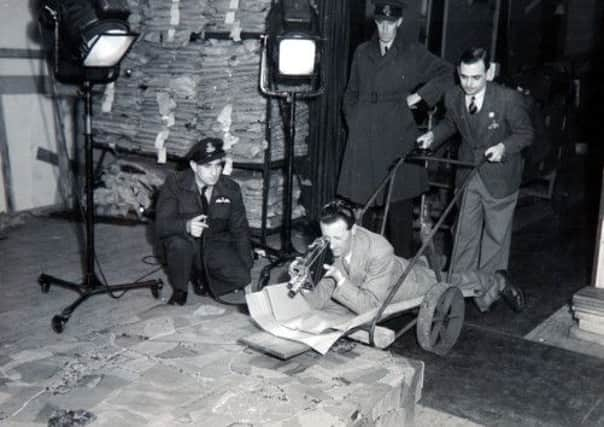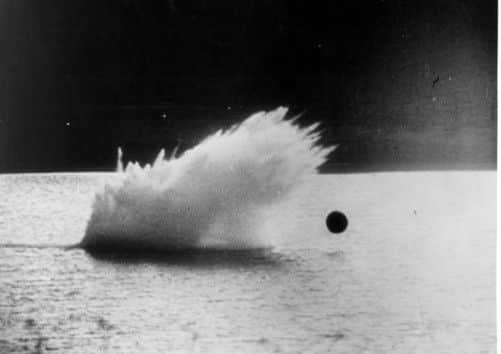Flight into history and film legend


Sunday, May 16, 1943.
The Operations room at Grantham was buzzing with tension. Far away, in the skies above Germany, 19 Lancaster bombers from the newly formed 617 Squadron were en-route to the giant dams that fed water into the industrial heartland of the Ruhr.
Their mission: to fly at a height of just 60ft and drop a new secret weapon into the waters of the Möehne, Eder and Sorpe dams, a bouncing bomb that would barrel across the surface before colliding with the wall of the dam and sinking to the bottom, where it would explode with devastating effect.
Advertisement
Hide AdAdvertisement
Hide Ad

The purpose was to breach the dams, the primary source of pure water for steel production in the Ruhr. It was known as Operation Chastise.
Pacing the floor were the very different figures of scientist Barnes Wallis and Air Marshall Arthur “Bomber” Harris, Commander-in-Chief of Bomber Command. With agonising slowness staccato radio reports filtered in with updates on progress.
At 11 minutes past midnight on May 17 the 24-year-old mission leader, Wing Commander Guy Gibson, reported that his bomber was being fired on by anti-aircraft batteries.
Twenty-six minutes later Gibson’s radio operator reported that the special weapon had been dropped, that it had exploded as planned but that the dam had not been breached. There followed a ghastly silence lasting a further 13 minutes. Then, as Wallis, Harris and other RAF personnel waited impotently, more radio messages came through.
Advertisement
Hide AdAdvertisement
Hide AdThe third plane reported the same as Gibson. Later it was discovered that the second Lancaster had been destroyed by its own bomb which had struck the top of the dam and exploded in the air beneath the aircraft.
Wallis was at his wits’ end. He had been responsible for sending more than 130 young men on what was rapidly emerging as a suicide mission. His weapon had not worked.
Three minutes later aircraft J-Johnny signalled that its bomb had been released and had exploded. Then came the sound everyone wanted to hear: Gibson gave the code word to confirm that the Möehne had been breached. The dam was well and truly busted.
Gibson led his crews on to the Eder which was hit by bombs from Zebra, Nelly and Zulu. It too was breached. But the attack on the Sorpe was unsuccessful. Two planes, flying low to avoid German radar, hit the sea and had to return to base. Two more were never heard of again. And the only two planes to drop their bombs were unable to breach it effectively.
Advertisement
Hide AdAdvertisement
Hide AdBack at base Harris congratulated Wallis and a call was put through to the White House where Winston Churchill was meeting President Roosevelt. After dealing bludgeon blows on Hitler, Bomber Command had delivered the rapier thrust. But the celebrations were cut short when a distraught Wallis was informed of the cost of the raid: 56 personnel had been killed and eight planes lost.
The flyers’ story was made for the movies and 12 years after the raid it was immortalised on film as The Dam Busters starring Richard Todd as Guy Gibson and Michael Redgrave as Barnes Wallis.
During the 1950s Todd was one of Britain’s most popular stars. He worked with Alfred Hitchcock on Stage Fright, with Bette Davis on The Virgin Queen, played a vigorous Robin Hood for Walt Disney, joined the all-star cast of the D-Day epic The Longest Day and earned an Oscar nomination as a dying soldier in 1949’s The Hasty Heart.
But it was as Wing Commander Guy Gibson that the public took him to its collective heart. Todd attended countless events at Derwent reservoir in Derbyshire, where the pilots of 617 Squadron used the upper dams – including the three-mile long Ladybower reservoir – for training runs.
Advertisement
Hide AdAdvertisement
Hide AdSpeaking in 2003 Todd and Squadron Leader Ted Wass, the secretary of the Dam Busters Association, recalled both the film and its impact and the recollections of the men who flew on the raid.
“Right from the beginning it had been decided that the thing had to be factual and true,” said Todd, who was a contract artiste with Associated British Pictures when he landed the role of Guy Gibson.
“Sadly I wasn’t able to meet Gibson and hear his version. But I got a pretty good idea of what he was like, his little foibles and his little mannerisms which I tried to copy as closely as I could. Gibson had the VC, DSO and bar, DFC and two bars… incredible!”
“Having served with the survivors of the raid, they were all very proud to have taken part in it,” said Wass.
Advertisement
Hide AdAdvertisement
Hide Ad“It made headlines. At that period, 1943, things weren’t going all that well for us. It was a big morale boost, of course, from the publicity point of view.”
Todd was a vociferous defender of the raid. As well as destroying the dams it obliterated much of the surrounding countryside and killed hundreds, maybe thousands, of civilians. “There were so many people writing about it saying it was a waste of time and killed lots of people and so on and so forth. What people forget are some of the other effects that it had.
“For example, because of the destruction that it caused in the Ruhr valley the Germans had to withdraw tens of thousands of members of the Todt organisation who were building the coastal defences. As a result they were not as strong when D-Day came as they would have been otherwise.
“So although nobody thought of that particularly, we have every reason to be very grateful for the fact that there was a dams raid. Quite apart from the effect that it had – the floods and the interruption of industry and so on. It had a big effect. And of course morale was a big thing. It was very good for morale.”
Advertisement
Hide AdAdvertisement
Hide AdAn unusual aspect of Operation Chastise surfaced many years later when Wass became aware of several fraudsters who embellished their war records by claiming to have participated in the dams raid.
“It’s sad because it’s people who are deceased, perhaps, and the sons and daughters say ‘Father was on the dams raid. Can you tell me which aircraft he flew in?’ And of course we have every record available [so] I can assure you that they’re all fictitious.
“In this country I am aware of a person who has the Dam Busters’ crest on his headstone and he wasn’t even with the squadron. I had the picture of this fellow with his ‘crew’ under a Lancaster at Scampton and it was an Air Training Corps officer. The half a dozen chaps with him were Air Training Corps cadets! They were all young lads. It’s sad when people tell these stories.”
Ted Wass joined 617 after the dams operation, but took part in the sinking of the Tirpitz in November 1944. He died in February 2009, aged 88. Richard Todd, who gave up his career as a fledgling actor to join up the day after war was declared in 1939, parachuted into occupied France on D-Day and played his own commanding officer, Major John Howard, in The Longest Day. He died in December 2009, 10 months after Ted Wass, at the age of 90.
Advertisement
Hide AdAdvertisement
Hide AdTo the end of his life Todd was proud of being in The Dam Busters and proud of what the film represented.
“It was such an engrossing true story,” he said. “Michael Anderson, the director, decided that he wanted to make it [in] black and white because he didn’t want a pretty picture; it was not a pretty story. And furthermore he wanted to make it a sort of documentary and documentaries in those days were black and white.
“Also we had some film footage of the bomb trials in black and white and we wanted to use those. We’d go to the rushes every day and see what we had been shooting the day before and it was all there on the screen. It was just so thrilling to have been a part of that picture. It really was wonderful.”
There will be a Lancaster flyover at Derwent Reservoir on Thursday, May 16, at 1pm by the Battle of Britain Memorial Flight. Afterwards the aircraft will fly on to Chatsworth.
The Dam Busters is available on DVD from StudioCanal.